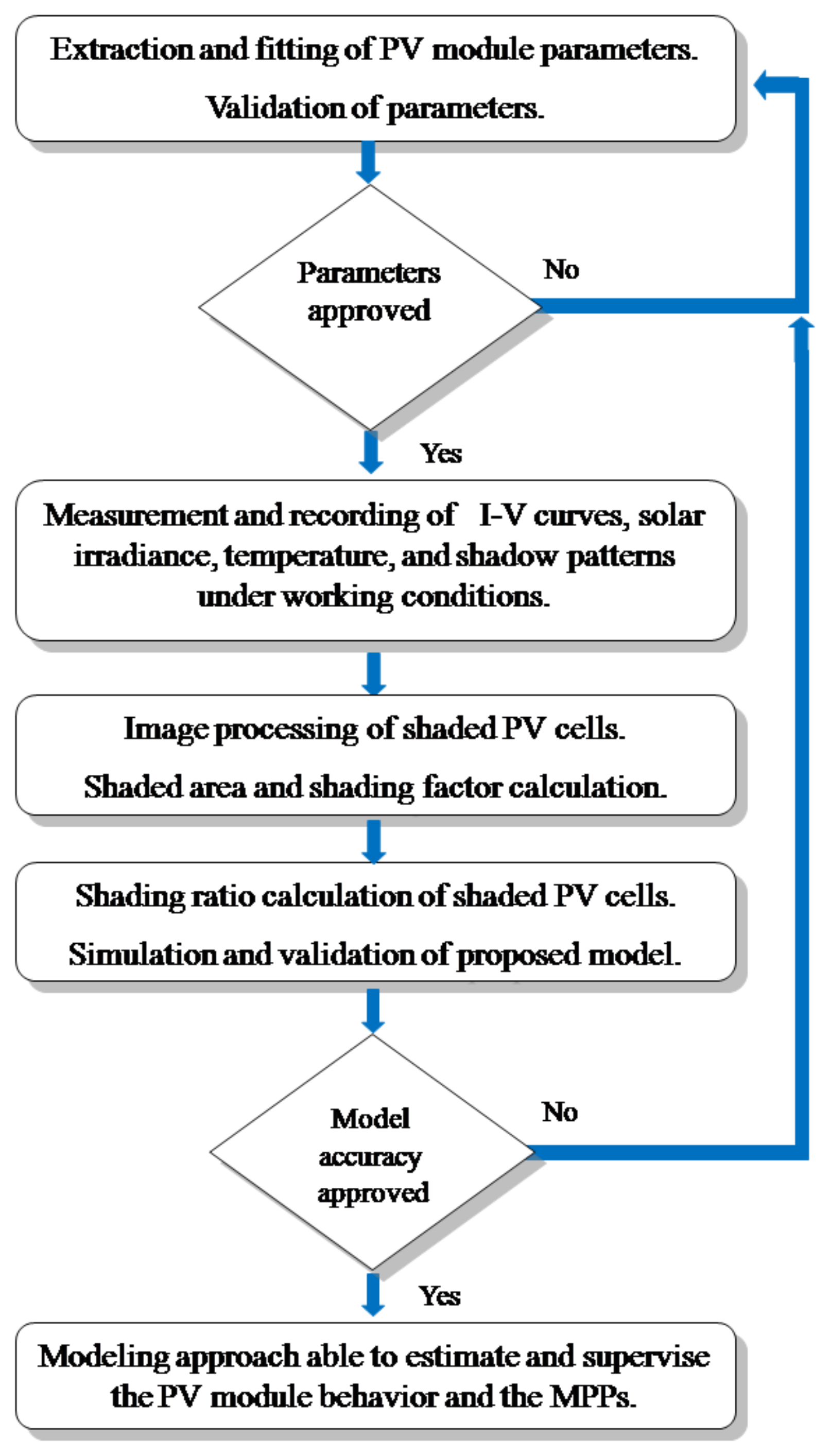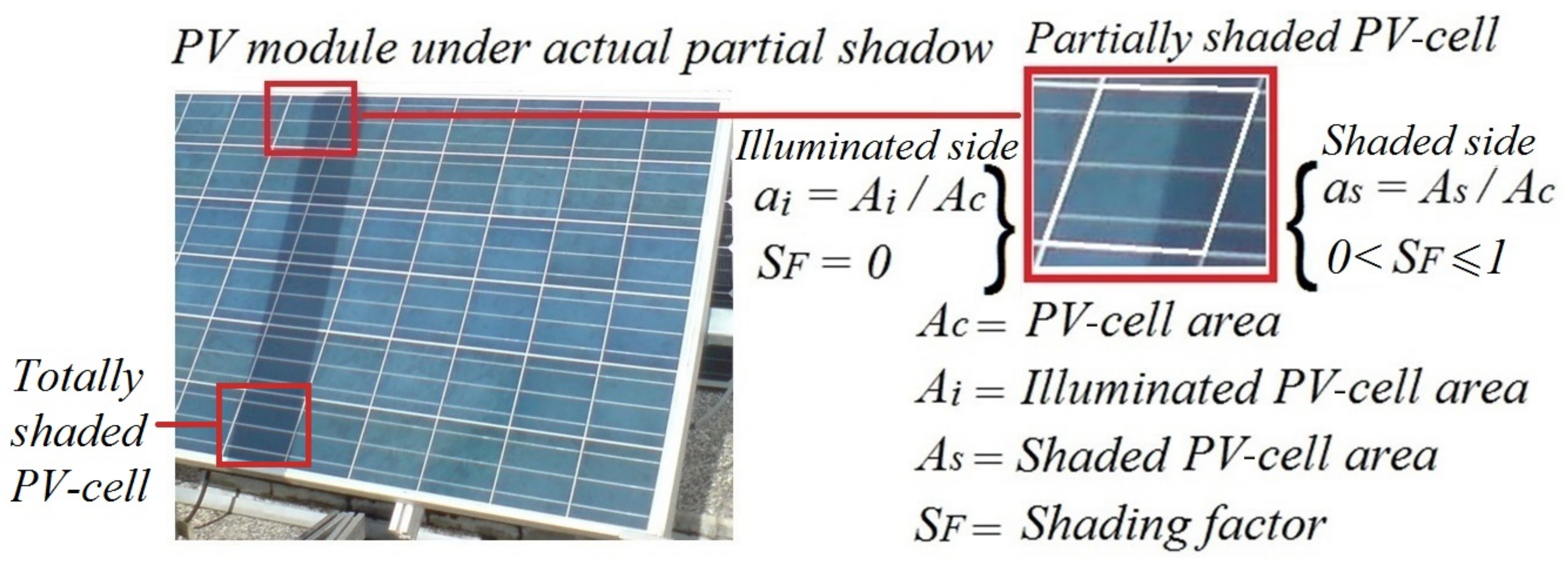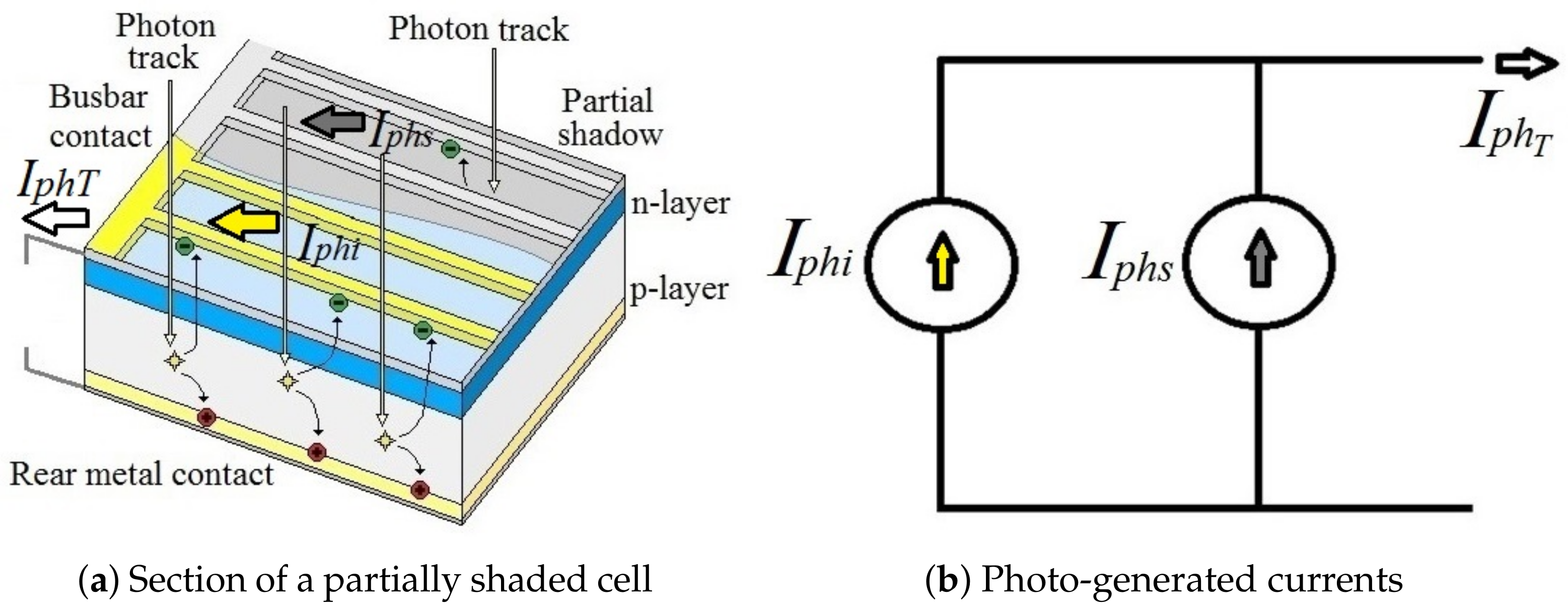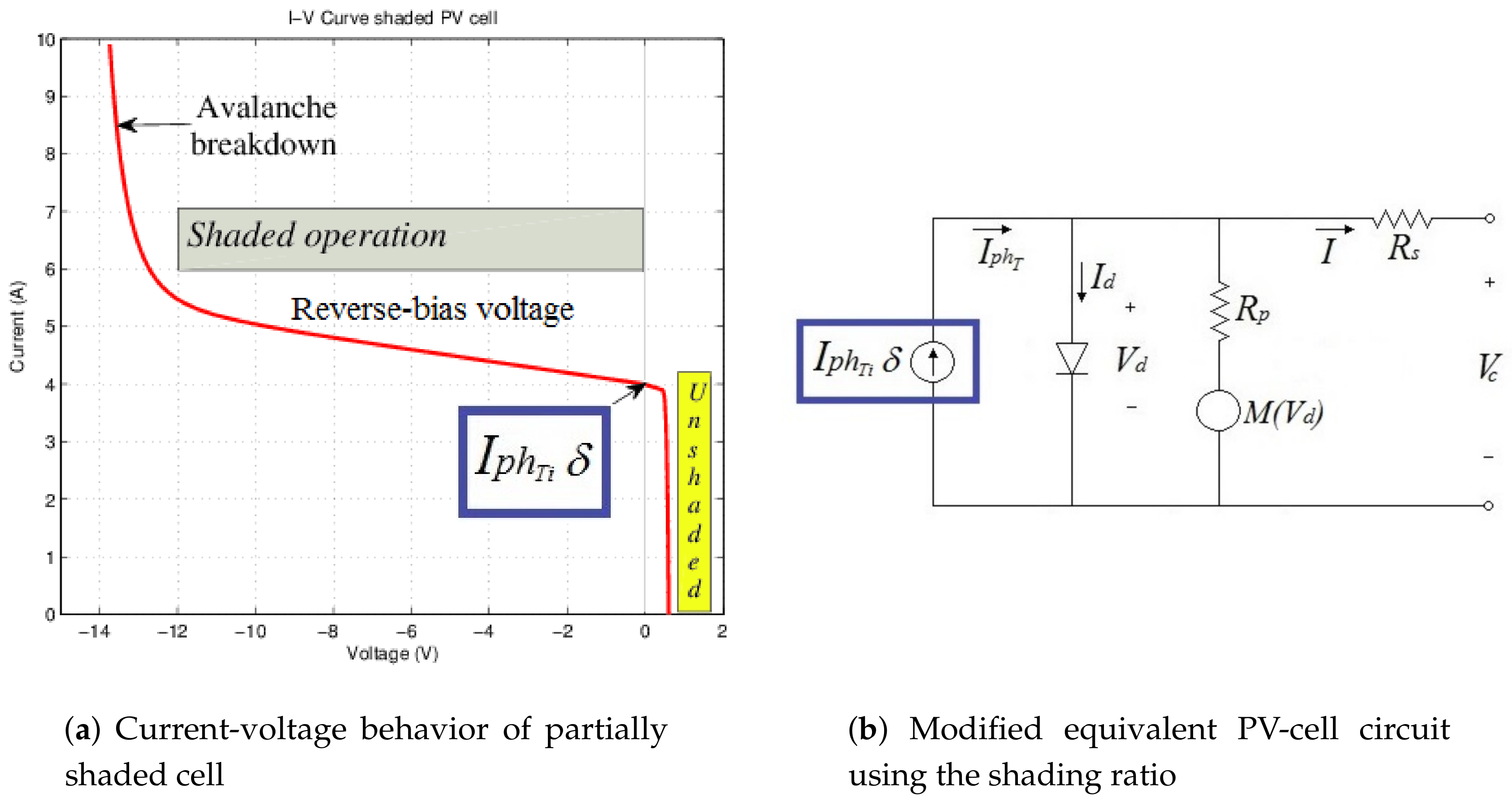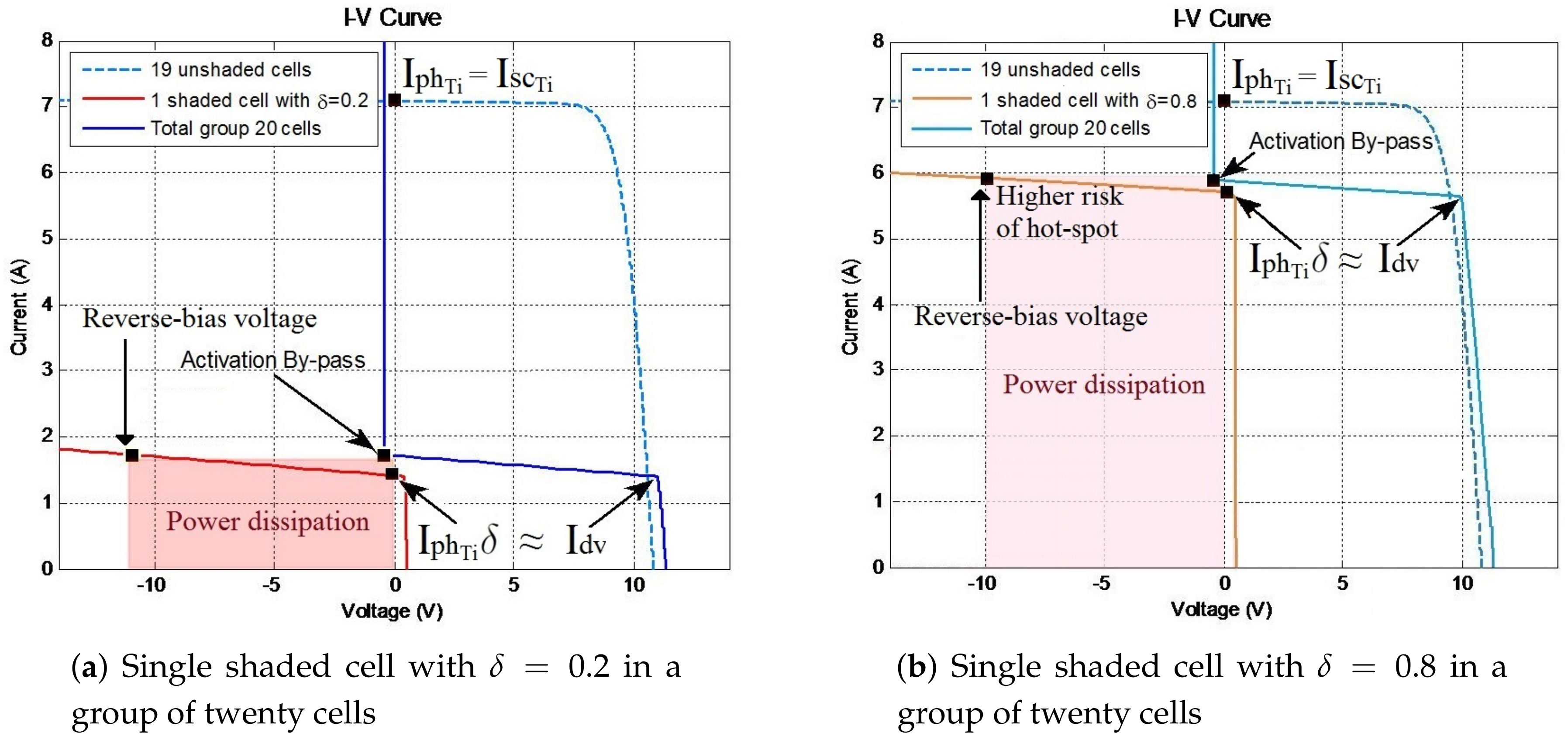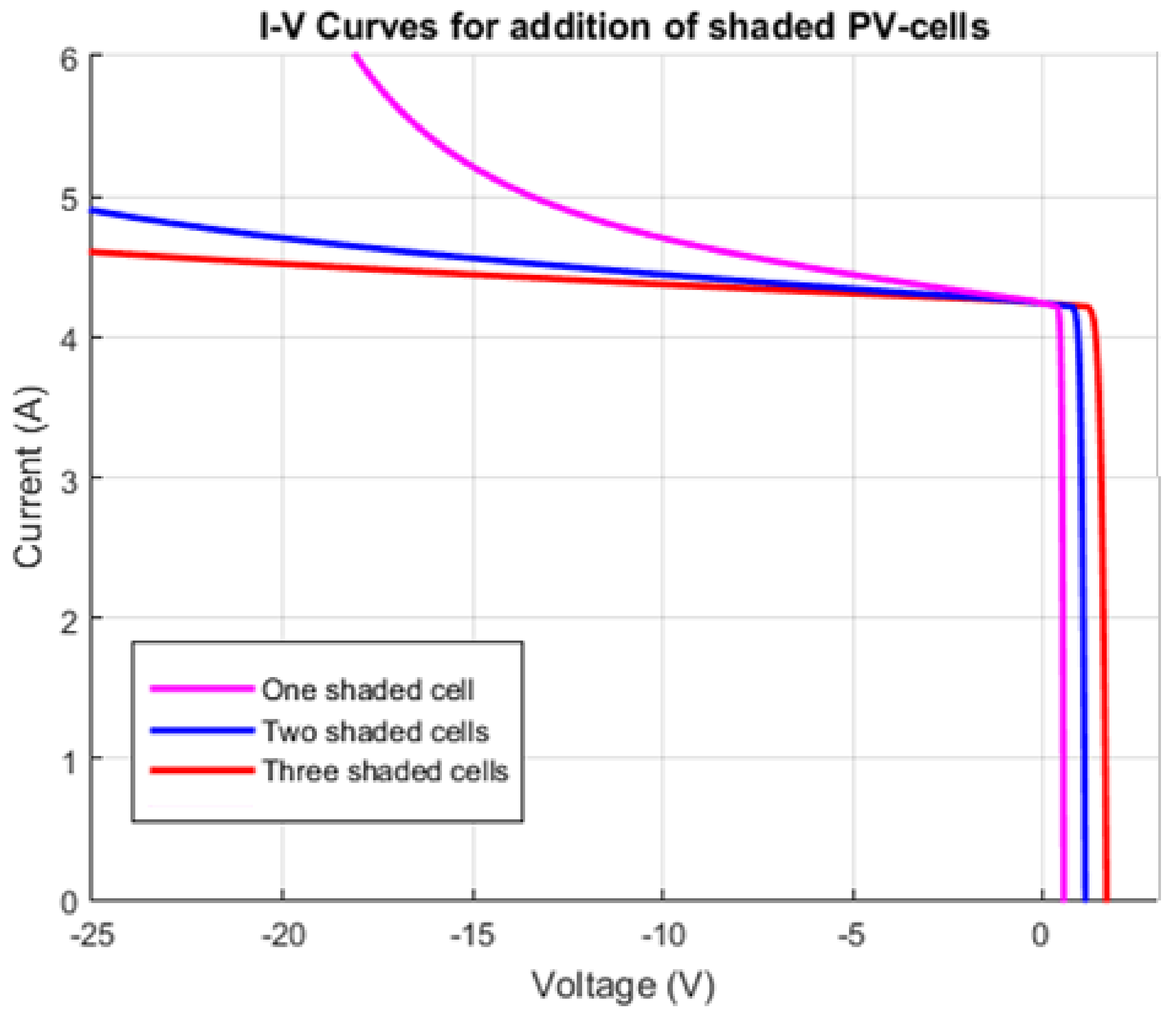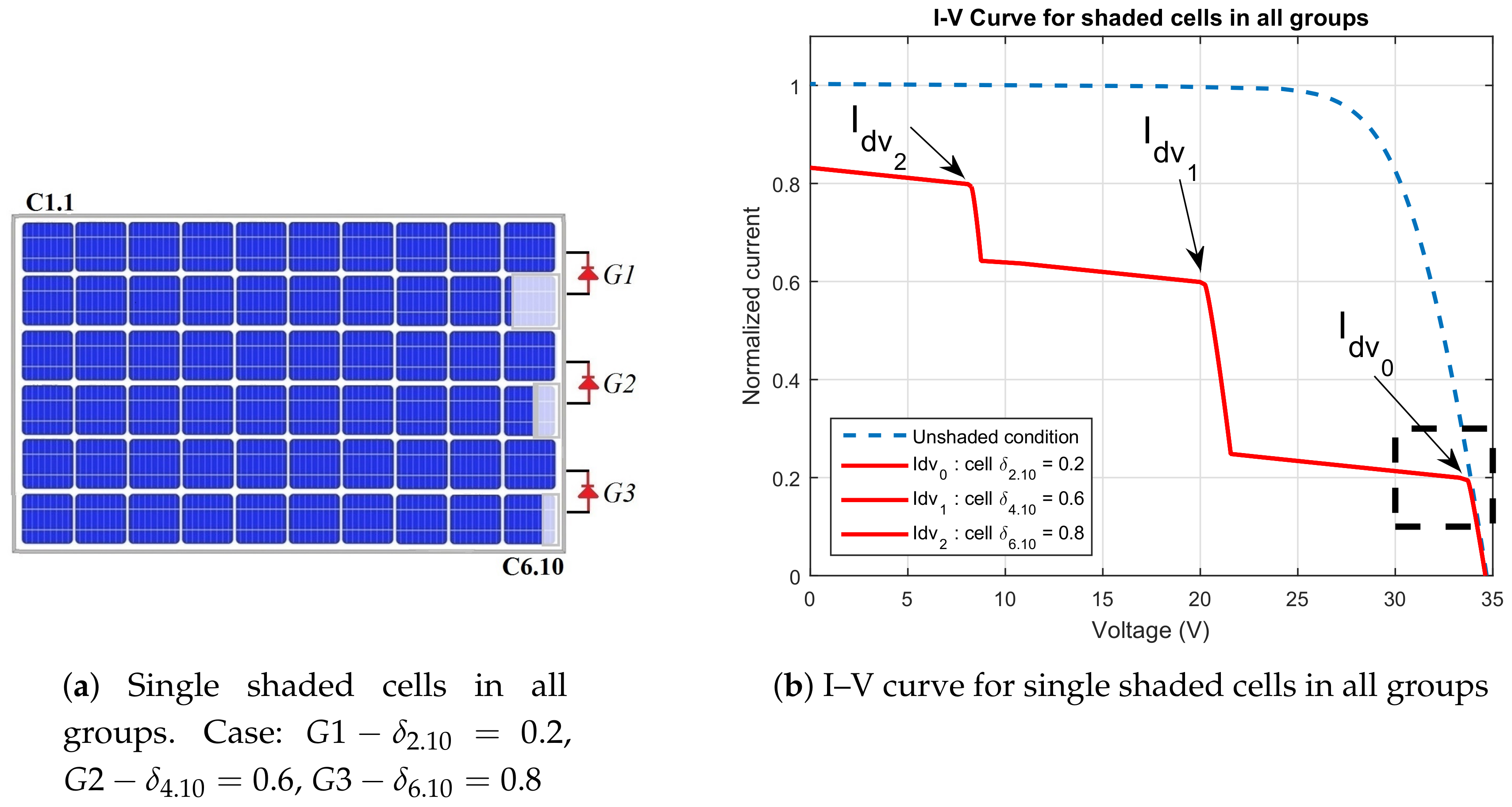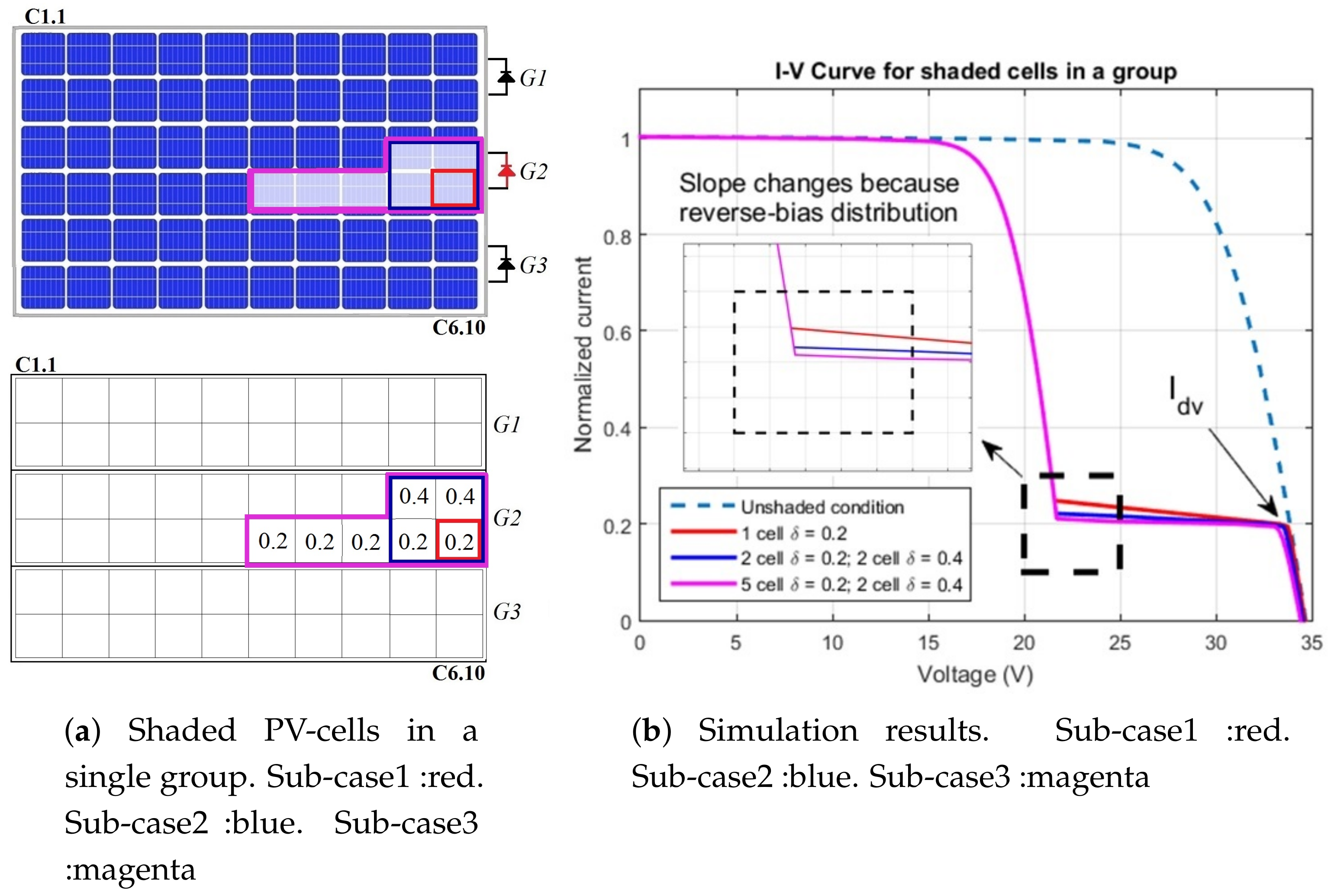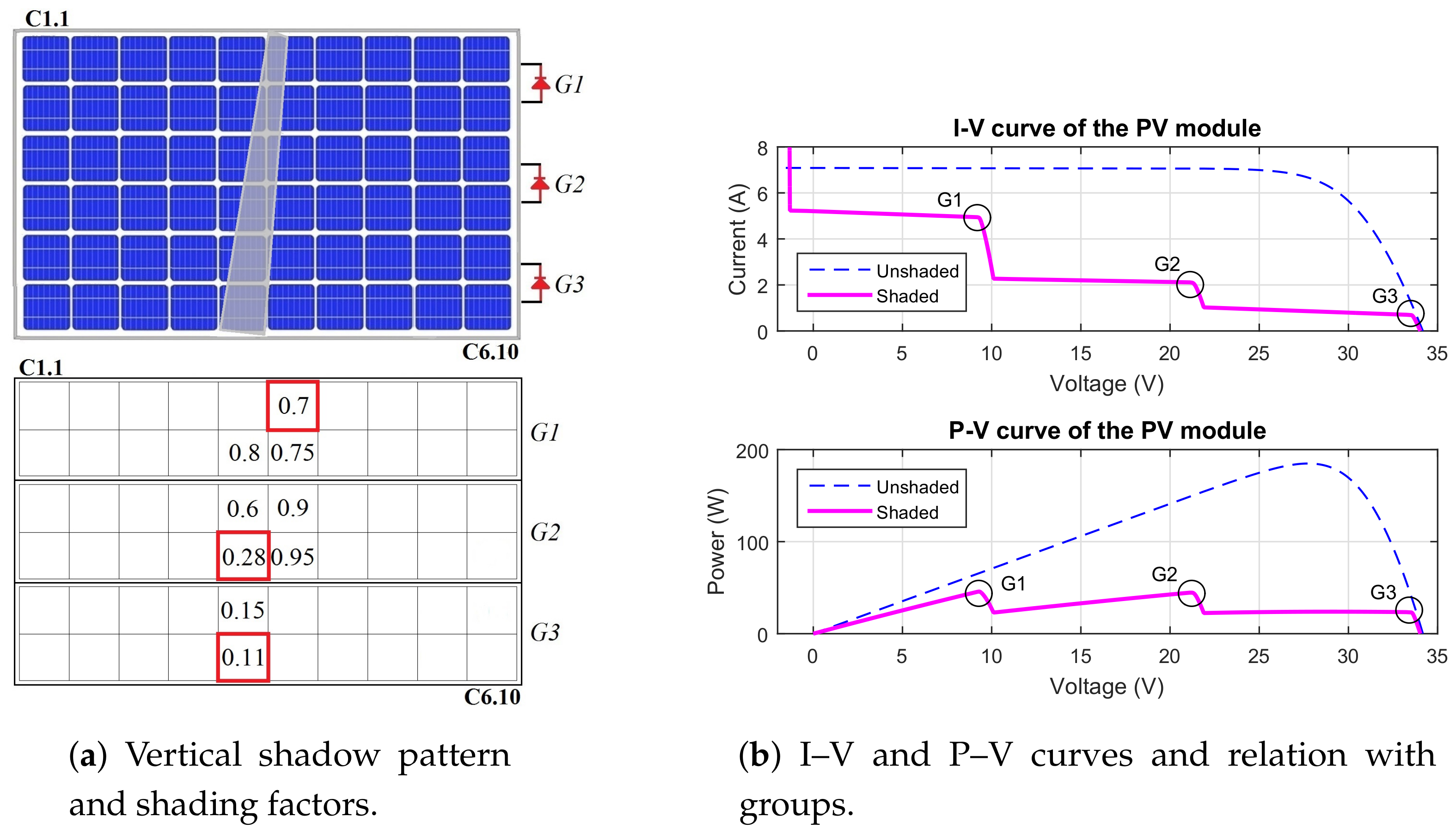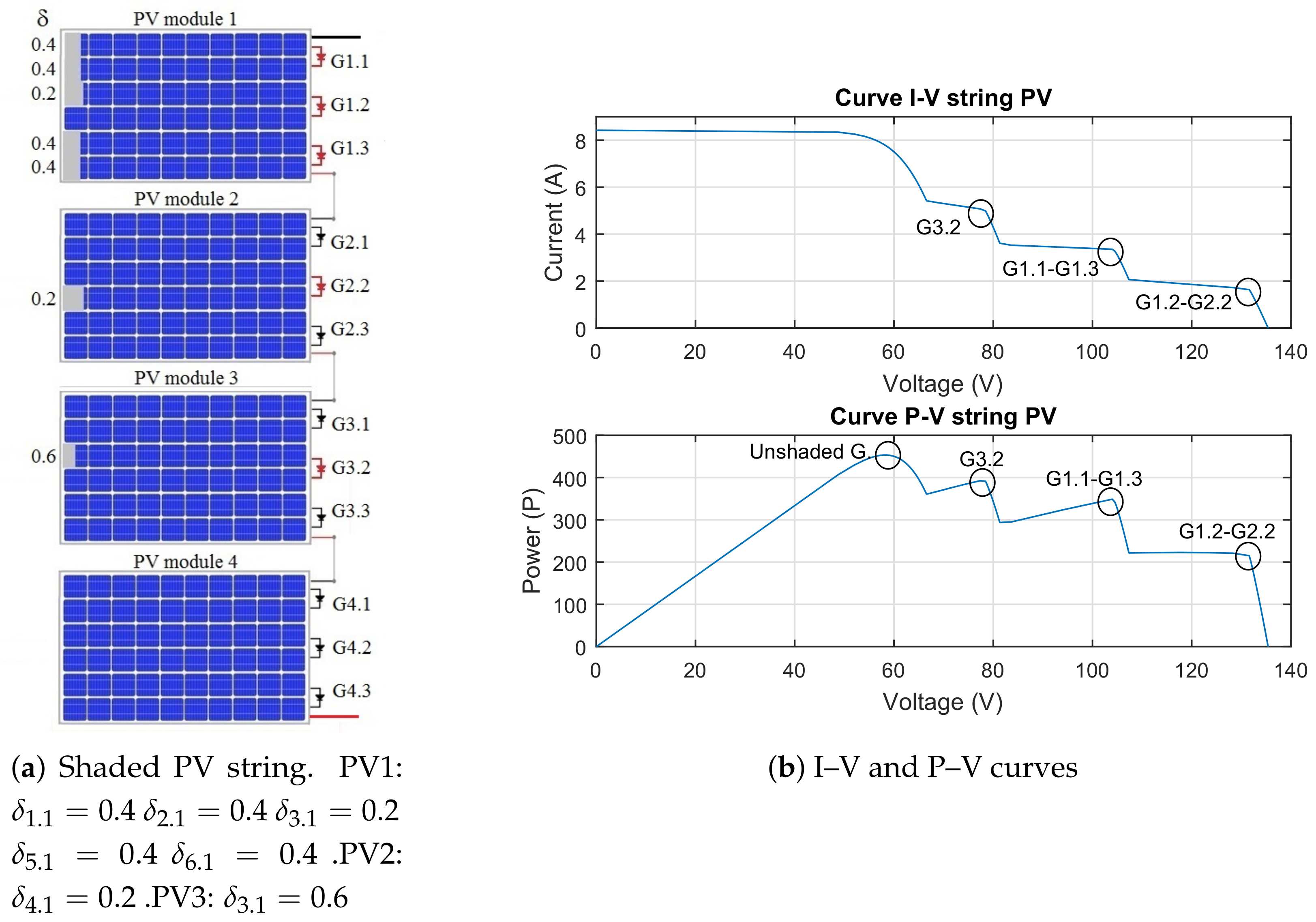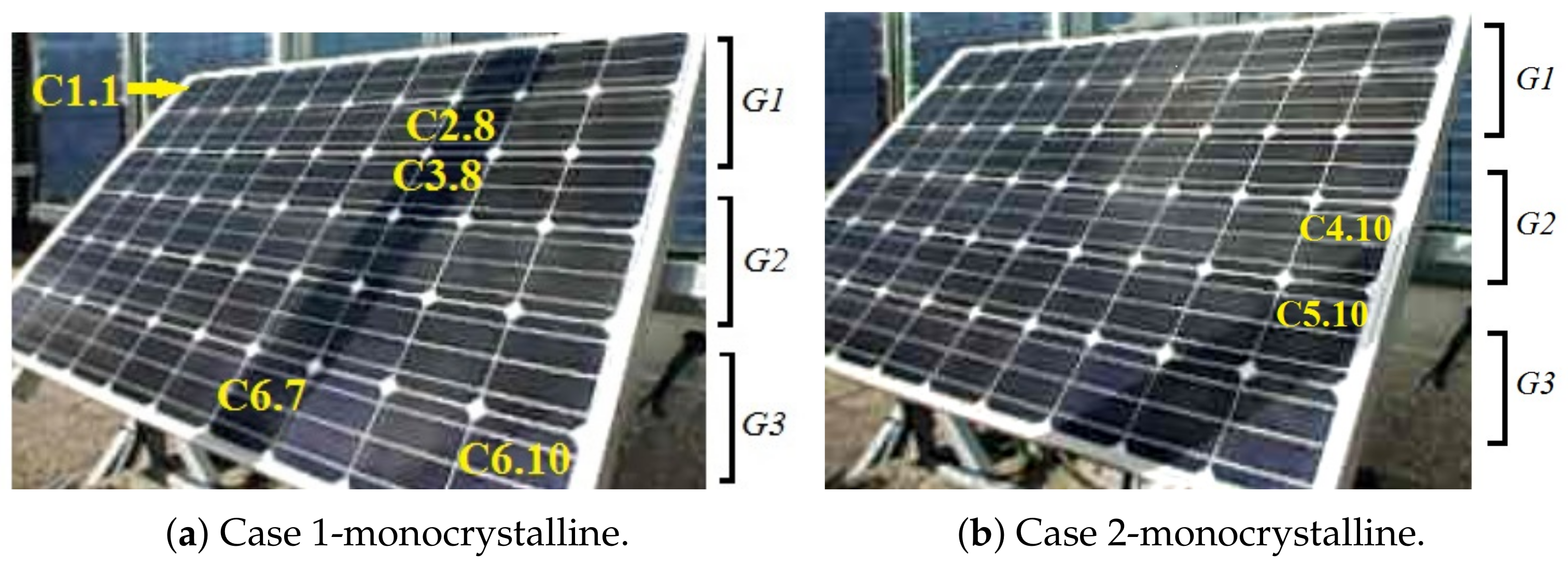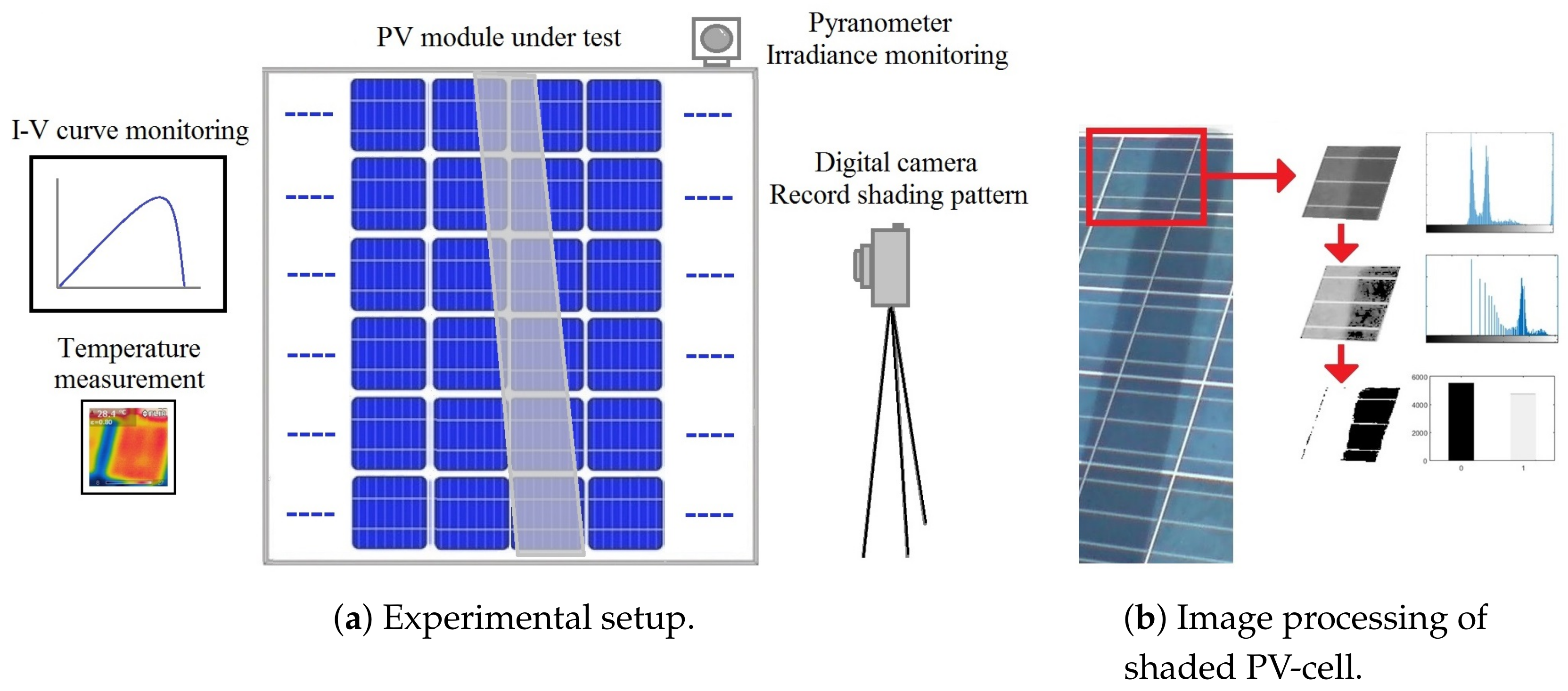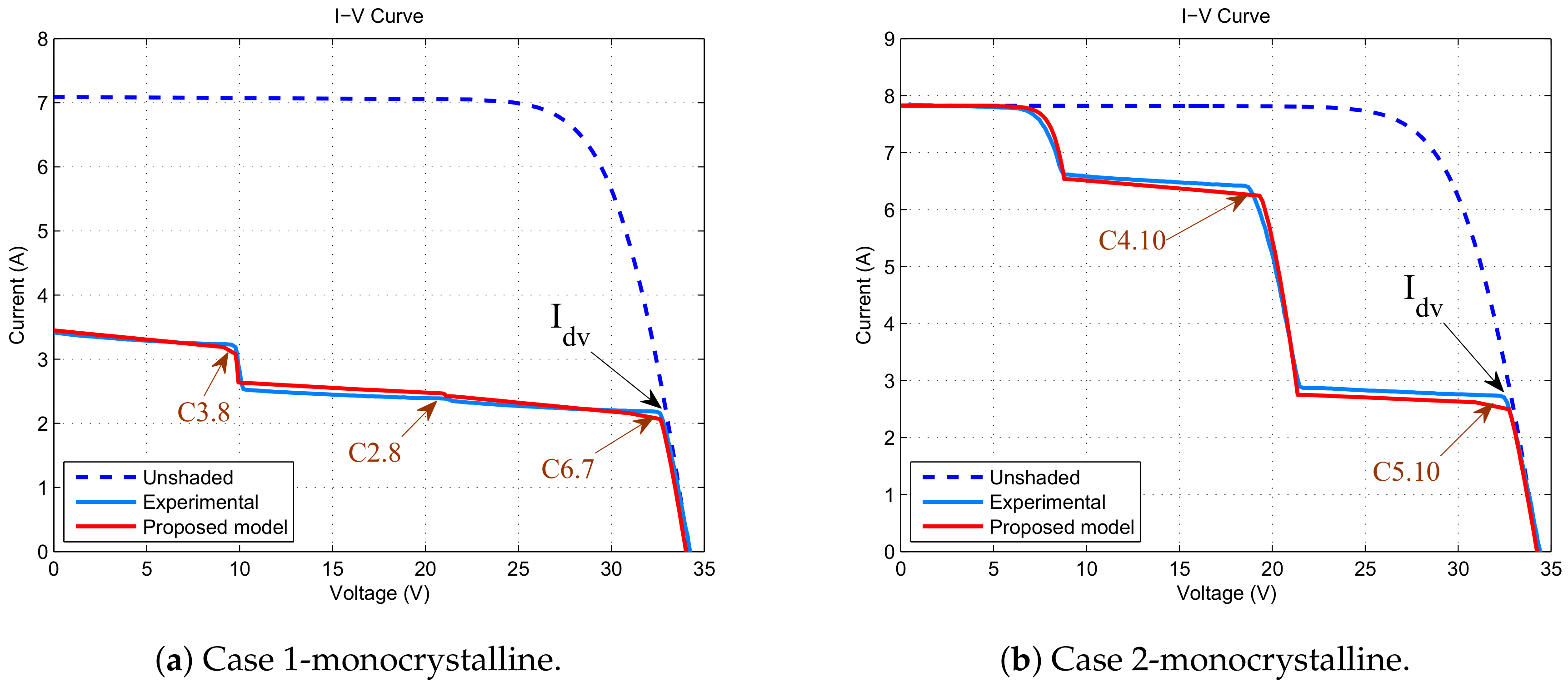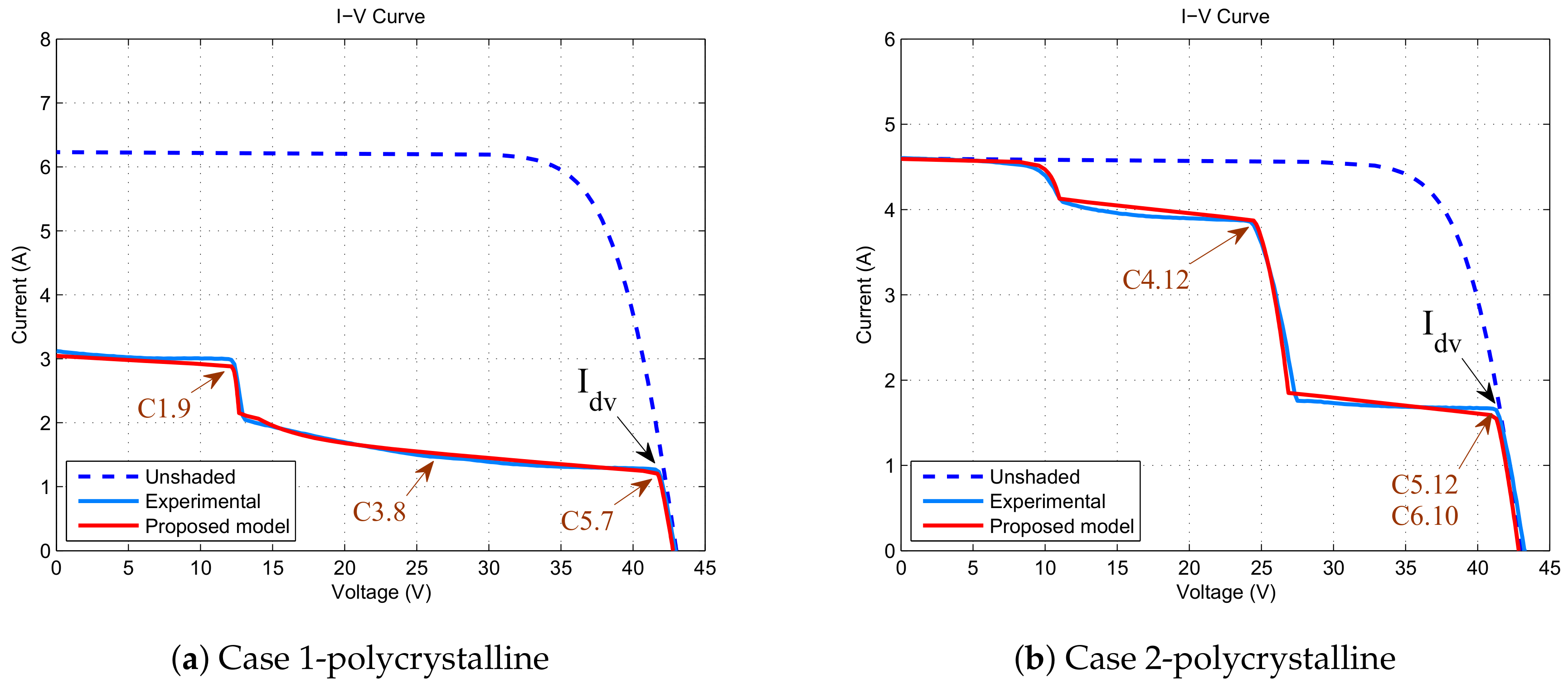3.1. Partially Shaded PV-Cell Model
Figure 3 shows that, in a PV module, the partially shaded cells have two main shadow features. The first feature is the shadow geometry represented by
where
is the fraction of shaded cell area and
is the fraction of illuminated cell area. The second shadow feature includes the optical properties of the solar irradiance on the PV module represented by the shadow transmittance
and the shading factor
. The shadow transmittance
is defined by the ratio between the scattered irradiance
on the shadow and the incident irradiance
, where
[
18].
means that all the available irradiance is blocked in the interest region. In contrast,
means that all the available irradiance shines on the interest region because the scattered irradiance becomes
. The shading factor
is defined in Equation (
3) to describe the shadow opacity [
36],
where
.
means that the available irradiance shines on the interest region. In contrast,
means that all available irradiance is blocked in the interest region. Then, the relation between
and
is given by Equation (
4):
Physical meaning of Equation (
4) shows that the shadow parameters of shading factor
and shadow transmittance
are complementary. For instance, a totally shaded PV-cell (
) with a shading factor
means that only the 20% of the available irradiance achieves the PV-cell surface, which represents a shadow transmittance
.
Figure 4a shows a 3D schematic section of a partially shaded PV-cell. In
Figure 4,
and
represent the photo-generated currents in the illuminated and shaded areas.
defined as the total photo-generated current. As shown in
Figure 4a, electron–hole pairs are generated when photons arrive at the p–n junction in the illuminated area. As a result, a photo-generated current
is produced in the illuminated area. In contrast, fewer photons can arrive to the p–n junction in the shaded area, which produces lower photo-generated current
in the shaded area. Therefore, using a simplified approach, the total photo-generated current
depends on contributions of shaded and unshaded areas, which is defined in Equation (
5).
Figure 4b shows the equivalent circuit for the photo-generated currents [
28].
Using the current density definition
for linking the electrical characteristics and the shadow geometric, we obtain Equation (
6):
Considering the relation between the illuminated and shaded current densities given by the shadow transmittance,
,
as described previously
and
. Thus,
Given that
represents the photo-generated current produced per unit cell area in the illuminated side and
defined as the total PV-cell area, the factor
can be interpreted as the photo-generated current
that should be provided by the PV-cell in totally illuminated conditions . Therefore, Equation (
7) can be rewritten as seen below:
The physical meaning of Equation (
9) represents that the total photo-generated current
is proportional to the totally illuminated photo-generated current
given a ratio that depends on the shadow properties [
28]. Equation (
9) shows that the total photo-generated current depends on the shaded area percentage
and the shadow opacity
but is independent of the shadow shape. Defining this relation by the shading ratio
, Equation (
10) is obtained:
Thus, the total photo-generated current
is given through Equation (
11). In the
expression, the totally illuminated photo-generated current
is evaluated using Equation (
12) and considering
as the incident irradiance in totally unshaded conditions, which was clarified previously in Equation (
2):
In addition, Equation (
13) is defined by considering
as the totally illuminated short-circuit current for unshaded cell conditions:
We propose extending the model presented by Bishop [
15] while using
for reformulating Equation (
1) and Equation (
15). At this point, it is important to highlight that the shading ratio
depends on the quantifiable parameters
and
. Therefore,
is also quantifiable.
Figure 5a outlines the current–voltage behavior of a shaded PV-cell according to Equation (
15). The equivalent PV-cell circuit is shown in
Figure 5b. This simplified
factor improves the description scope of shaded PV systems including measurable shadow features without needing to increase the computational effort.
Equation (
15) is a nonlinear equation that can be solved using numerical methods. The numerical method usually employed to solve these types of equations is the Newton–Raphson method [
4]. The method starts with a function
defined as
as rewritten below in Equation (
16):
Given that the function satisfies the condition
, the following iterative process is repeated until a sufficiently accurate value is reached:
The solution of the iterative process in Equation (
17) describes the PV-cell voltage given the influence of the shading ratio
and a known
I current. The solution of this iterative process is performed for a range of
I currents from 0 to
and for the respective shading ratios
of shaded PV cells. This method allows for calculating the voltage at the PV-cell level under several working conditions. Nevertheless, a series of connections of PV-cells form PV modules and it is required to go in depth about this aspect. The following section presents a systematic perspective to analyze the influence of the shading ratio on PV modules.
3.2. Influence of the Shading Ratio on the PV Module Behavior
This section relates the previous proposed approach with shadow patterns to extend the shadow impact analysis at the level of PV modules. Series connections of PV-cells form PV modules, and PV module manufacturing usually connects by-pass diodes to groups of PV-cells for decreasing the damage risk [
29]. Thus, the voltage in a PV module
with
m groups of
q PV-cells and by-pass diode voltage
is given by Equation (
18):
The PV-cell voltages
come from the solution of the nonlinear Equation (
16) by applying the numerical Newton–Raphson method of Equation (
17). In addition, the parameters
,
,
, and
of Equation (
16) have been extracted according to the iterative methods presented in Ref. [
5]. The parameters
k and
n of the multiplier factor proposed by Bishop in Ref. [
15] have been extracted using nonlinear curve fitting methods from experimental results in shaded conditions with unconnected by-pass diodes. The parameter
depends on the PV module technology and it has been fitted according to operation regions proposed in Ref. [
29].
Solutions of Equations (
15) and (
18) for a group of twenty cells with a single shaded cell provides the results in
Figure 6. As shown in
Figure 6, a partial shadow in a single cell can change the normal behavior of the group drastically. Denoting
as the divergence current where the I–V curve diverges of normal operation in shaded conditions given by
, and the comparison of results in
Figure 6a,b allows for deducing the behavior of
described by Equation (
19):
In addition, the totally illuminated short-circuit current was considered in Equation (
13) as
. Then,
Equation (
19) is deduced because the voltage in the shaded PV-cell begins to be negative when the PV-cell current is higher than
, which leads to a prominent change of the I–V curve. If the PV-cell current follows increasing, the PV-cell voltage is each time more negative until achieving the activation of the by-pass voltage. In this operation condition, the shaded PV-cell dissipates power due to the negative voltage and risk of damage can arise.
Figure 6 shows that the situation can get worse if the shading ratio is higher because the dissipate power increases. This situation can induce hot-spots if the partial shadows are small and permanent. Failures of this type have been reported in literature and require preventive actions to avoid the deterioration of the PV system performance [
37].
Figure 6 also allows for deducing the relation between the shaded PV-cells in a group with the lowest shading ratio. Assuming a case in which the shaded PV-cells of
Figure 6a,b are in the same group, the lowest shading ratio of
Figure 6a would lead the group toward the by-pass activation condition. Therefore, the shading ratio of the
Figure 6b would have a minimum impact in the divergence current because the by-pass diode is already active. This operation principle can be extended to several shaded cells with different shading ratios because the lowest shading ratio is the first to activate the by-pass diode.
Figure 6 shows that the reverse-bias voltage is critical for the structural healthy of the PV-module. For that reason, in
Figure 7, the I–V behavior is depicted in reverse-bias condition for several shaded cells. In this case, one PV-cell has a higher slope because the proximity of the breakdown voltage. In contrast, the illustrative example of
Figure 7 shows that increasing the
N shaded PV-cell multiplies the negative voltage
N times because the PV-cell are connected in series. Therefore, the slope in the negative region decrease and for a given current interval
.
Figure 8 extends the analysis to several shaded PV cells in a PV module. These figures show the interrelation between the divergence currents and the maximum power points (MPPs). As shown in
Figure 8,
z represents the index for the lowest shading ratios
in each group where
and
g is the total number of groups connected in series.
and
are the voltages and currents at the MPPs. The relation between the MPPs and the lowest shading ratios
is given by the behavior of the divergence currents
and the local MPPs.
Figure 8 allows for deducing that
because the MPPs arise around the current divergence. Nevertheless, an exception to this pattern is presented in unshaded groups where
.
is defined in Equation (
21) as a proportional relation between the voltage difference
and the corresponding shading ratio
for the shading ratios arranged from the lower to the higher
. The physical meaning of Equation (
21) represents that the voltage displacement of
in relation to the local MPPs in an unshaded condition is associated with the shading ratio
.
All groups are connected in series and each group proportionally contributes to the open circuit voltage
. For this reason, the voltage
at the local MPPs is expressed as a fraction of
and
. For the illustrative example of the
Figure 8, the expressions for the voltages
at the local MPPs are given from Equation (
22) to Equation (
24), where
is the forward by-pass diode voltage which displaces the proportion of
:
A general expression of
is deduced in Equation (
25) for
g groups and
,
For
and
,
For unshaded groups
and
is given by Equation (
28),
Equations (
27) and (
29) allow a fast approximation to the MPPs for known shadow patterns and unshaded operation parameters. The procedure to evaluate the MPPs is described as follows:
- Step 1:
Determination of the lowest shading ratios in each group, arrangement of shading ratios from the lower to the higher .
- Step 2:
Evaluation of , , , and from unshaded condition, considering .
- Step 3:
Calculation of
for
using Equation (
27) if
or Equation (
29) if
.
- Step 4:
In the special case of , the sequence of values for and are evaluated normally. However, only the highest value of power defines the region for the local MPP.
Given the proposed modeling approach through this section, the next stage will analyze the simulation of shaded PV modules.
